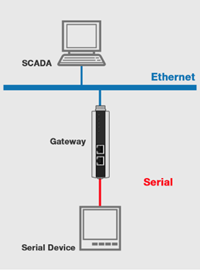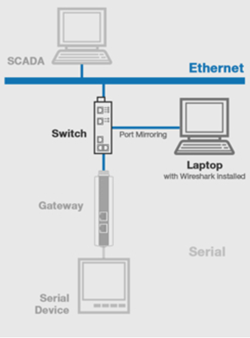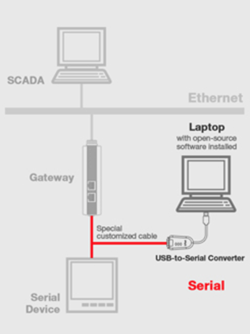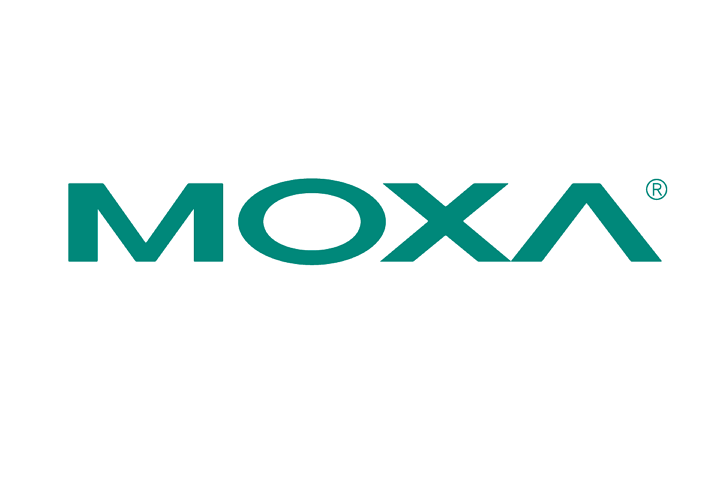In the era of the Industrial Internet of Things (IIoT), protocol gateways have assumed a crucial role in converting protocols between management systems and field devices during data collection. However, troubleshooting these protocol gateways can be a daunting task for an engineer. The main issue lies in the fact that engineers are not acquainted with the numerous protocols commonly encountered in various applications. Consequently, engineers often invest a significant amount of time and energy into the setup and upkeep of devices. Particularly, when a network malfunctions and a prompt solution escapes them, engineers find themselves in a difficult situation.
Understanding Both Sides of the Gateway

Gaining insight into the structure of a standard network is crucial for obtaining a comprehensive understanding of the troubleshooting process. Nowadays, most management systems, such as supervisory control and data acquisition (SCADA) systems and Human Machine Interfaces (HMI), gather data via industrial protocols like Modbus TCP, PROFINET, and EtherNet/IP. These management systems link to the network infrastructure through numerous switches. Protocol gateways, acting as protocol converters, communicate with SCADA or HMI systems through Ethernet on one end, while on the other end, they connect to field devices and interact with fieldbus protocols through serial interfaces like RS-232/422/485. Consequently, the significance of gateways in data collection cannot be overstated.
When a problem arises in a network, the first step should involve inspecting the devices, by examining the LED indicators, cable connections, pin assignments, and other factors. If the networking hardware is functioning correctly, the issue is likely related to protocol communication. Unlike hardware problems, communication issues cannot be easily identified without diagnostic tools. In the absence of such tools, troubleshooting communication problems can be incredibly laborious.
Insufficient Tools, More Challenges
When protocol gateways lack built-in troubleshooting tools, engineers face two major challenges: the need to install third-party software for capturing Ethernet packets and capturing serial data.
Wireshark, a popular open-source utility, is frequently used for basic protocol gateways that lack their own troubleshooting tools. To capture Ethernet data packets, the tool must be installed on the management system. However, due to several reasons, installing Wireshark on all management systems may not be feasible. For instance, some PLCs may not support third-party software installation, or security constraints may prevent Wireshark installation in SCADA systems. To maneuver around these obstacles, engineers must use a switch with a mirror-port function placed between the gateway and the management system. Subsequently, the mirror port needs to be configured to capture packets from the switch port connecting either to the gateway or the network infrastructure. Seasoned engineers can then efficiently analyze the captured packets to pinpoint the root cause. Ideally, the issue will pertain to the Ethernet side of the network, enabling a swift resolution.

However, the same does not hold true for issues on the serial side of a network. Troubleshooting serial communication is complex as capturing serial data on the bus is challenging. In the absence of troubleshooting tools, the only recourse is employing a USB-to-serial converter attached to a specialized serial cable which necessitates additional time and effort for creation. These components are then used to link the serial device to the gateway, with a computer tasked to capture the transmitted data through a serial analyzer tool. Understanding this data is intricate due to its raw format.

This form of troubleshooting can lead to increased costs due to the additional components and devices required, as well as the downtime needed to dissect the raw data.
Employ These Tools to Ease the Process
The fortunate news is that most customer-focused protocol gateways extend a helping hand to engineers by offering various troubleshooting tools such as protocol analysis, protocol diagnostics, and traffic monitoring.
The protocol analysis tool saves time by promptly signaling whether the issue originates from the Ethernet or serial side of the network. It also furnishes beneficial guidance on steering the troubleshooting process—especially advantageous for junior engineers with limited protocol knowledge.
The protocol diagnostics tool evaluates the protocol connection status and logs all errors to aid users in identifying the network failure’s root cause. Previously, pinpointing the reason behind a connection failure was arduous without understanding the events preceding the disruption.
The traffic monitoring tool assists in addressing communication issues by monitoring traffic logs that can capture Ethernet or serial data packets. However, most logs exhibit raw data, which is of limited value to many engineers. Therefore, a proficient traffic monitoring tool should have the ability to process the logs and translate the raw data into a more comprehensible format. Leveraging this tool enables engineers to efficiently pinpoint the root cause.
Moxa’s Offerings
Equipped with built-in troubleshooting tools like the communication tool, protocol diagnostics tool, and traffic monitoring tool, Moxa’s robust gateways significantly reduce downtime. These tools streamline the entire troubleshooting process by identifying network issues, evaluating protocol connection statuses, and monitoring traffic logs to track records. This eliminates the need for engineers to waste time unraveling the cause of downtime and allows them to focus on rectifying the problem swiftly. For additional details, download the white paper: How to Easily Troubleshoot Protocol Gateways
- Not Only for Automobiles: Discovering CANbus Technology in Various Industrial Settings - October 29, 2024
- Boost Your Network Performance: An Exciting Manual to PoE Switches! - September 10, 2024
- Understanding Gigabit Switches: Industrial vs Regular Gigabit - September 4, 2024


